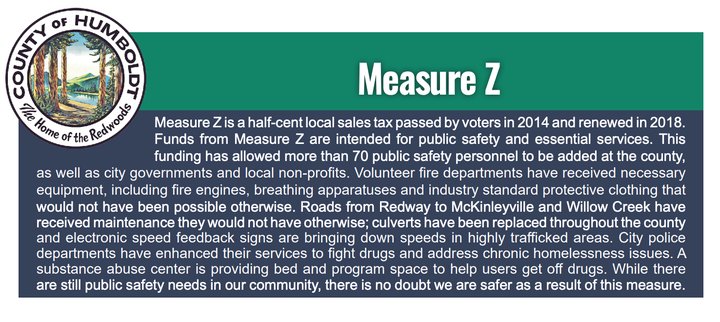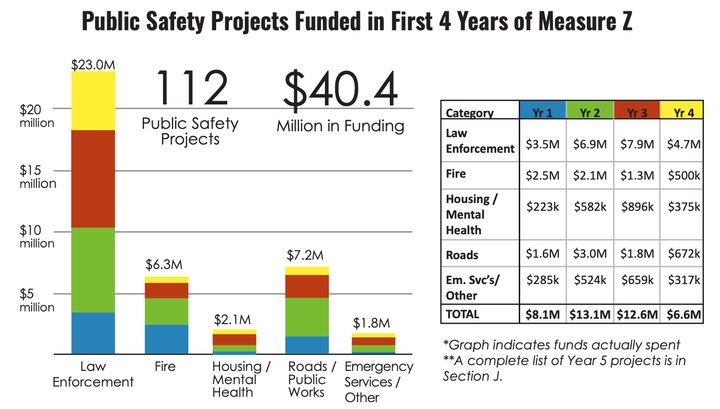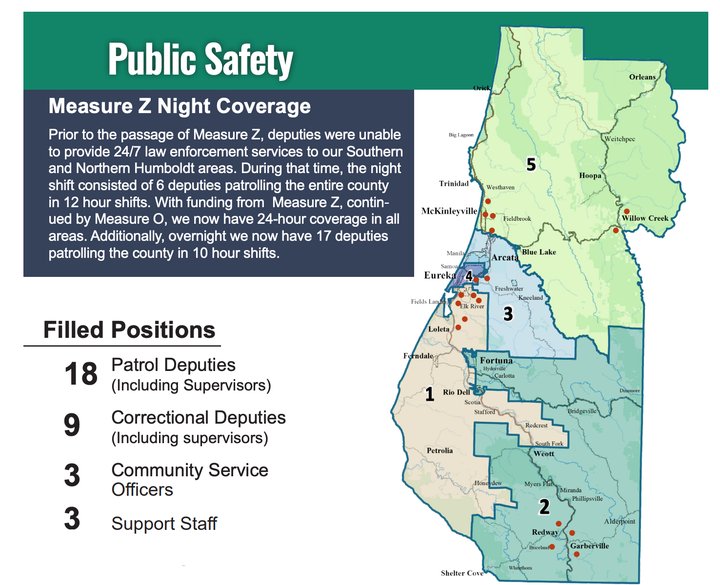
Screenshots courtesy of Humboldt County
For this round of funding allocations, the Measure Z committee has received 28 applications totaling $7,618,316 from governmental agencies, nonprofits and private sector firms. They are all seeking a portion of the tax-dollar-infused pie that has been dwindling in recent years.
Measure Z is funded through a half-cent sales tax that was passed back in 2014 and extended indefinitely by Measure O in 2018. The main scope of the measure is to “maintain/improve essential services” in the county. These include fire and law enforcement, services for victims of child abuse, road repair and others. Since its inception, over $40 million in funds have been spent, with the lion’s share going to law enforcement services. Once the county positions are funded, the remaining share is then doled out to a number of applicants. These applicants include nonprofits that help the homeless, ambulance services in rural areas, the Arcata and Eureka police departments, and others.

Measure Z funds over the years
However, a new trend has begun to emerge — a shrinking pot of money. In a previous interview with the Outpost, Glenn Ziemer, the chair of the Measure Z committee and representative for District 1, said he speculates the decline in sales tax dollars is due to the legalization of cannabis.
Ziemer said that he’s also concerned by the county’s tendency to spend the shrinking funds mostly on itself.
“We actually forwarded a letter to the Board of Supervisors conveying to them our concern that the county portion was beginning to overtake the fund and basically squeeze out the external applicants,” Ziemer told the Outpost. “Every year there are requests for about two to four times the amount of funds that are available.”
This round of Measure Z applications has police departments pitted against ambulance services, drug treatment centers pitted against county road departments and ambulance services that operate in the rural areas of Humboldt.
Access Humboldt and the 2-1-1 Humboldt Information and Resource Center need funds for back-up generators and other equipment during PSPS events. The Arcata Police Department wants funds for Juvenile Diversion Counselors, the Eureka Police Department wants funds for their Community Safety Enhancement Team and homeless outreach workers and the Humboldt Public Works Department is seeking around $1.5 million for road maintenance countywide.
The largest ask is coming from the Humboldt County Fire Chiefs Association, which wants $2.4 million for three reasons. First, to purchase new equipment for the rural areas in order to “bring them up to a nationally recognized minimum level,” the HCFCA request states. Second, to cover dispatch fees, a service currently provided by CalFire. Lastly, to cover out-of-jurisdiction responses, mainly in the 299/Redwood Creek/Mad River area.
“The cost of this ‘goodwill service’ falls to the residents within the existing district boundaries,” the HCFCA request states. It goes on to say that the HCFCA has made headway in finding long term funding solutions for this area, but for the time being funds are needed to cover costs whenever a need may arise.
This year’s Measure Z fund is $10,994,000, and county positions eat up about $7.8 million of that. This leaves roughly $3.1 million for outside agencies. Ziemer said there is general support amongst the committee for law enforcement and emergency services, especially those in rural areas.
“There has been a strategic determination to say, ‘We need to have these very basic services available countywide.’ So those programs have been funded through Measure Z,” Ziemer said. “Those services probably would not exist in the rural areas if it were not for Measure Z money.”
Ziemer wants to see a change to the process that automatically grants funds to county positions, and expressed some of his concerns about this in a letter sent to the Board of Supervisors back in Sept. 2019. In the letter, Ziemer requests a meeting with the Board to “address a developing financial trend where the inflationary increases to ongoing personnel costs are causing a significant decrease in the discretionary funding portion of the Measure Z revenue. The committee is concerned that this trend is accelerating at a pace that will result in the totality of the fund being allocated to ongoing personnel cost with no allocation to other applicants in the near future.”
This request from the Measure Z Committee resulted in the Board creating a task force made up of the Sheriff’s Office, the District Attorney’s office, the Department of Health and Human Services and other county offices that receive Measure Z funds. They are slated with trying to figure out what their future operating costs may be and what allocated positions are necessary to fulfill their public safety duties in the most efficient way.
Ziemer said the Task Force is supposed to report its findings sometime in mid-April.
The result of this automatic rollover process for county positions means that they never have to really compete for funds from the outside agencies, Ziemer added.
“As a result of this process, it means that the county positions never have to suggest any kind of competitive advantage compared to the outside applications,” Ziemer said. “To the degree that the county positions are never evaluated, you don’t necessarily end up with the best and the brightest and the projects that have the best cost-benefit return because they are never actually compared.”
Another roadblock facing outside applicants this year is a new policy that will only fund 100 percent of the requested funds. In years past, the Committee would partially fund projects so that the funds would be spread around to as many as applicants as possible. This change was passed on Jan. 23 with eight of the nine committee members voting in favor of the rule. The lone dissenter was Nick Kohl, representative for District 4.
“I feel that it is best to leave all of the tools on the table to give us the most opportunities to do the most good,” Kohl told the Outpost. Given this change in the policy, Kohl said he is focusing on funding two main applicants, the Humboldt Fire Chiefs Association’s request and the Eureka Police Department’s request.
“In talking with both [the City of Eureka and the [Eureka] Police Department, [the MIST program] has the biggest impact on their ability to respond to 911 calls,” Kohl said. “There are people dedicated to dealing with the homeless issue and that remains a huge aspect of their calls. It allows them to have people that are able to focus on [homeless issues], while they have other forces available for emergency response.”

Kohl feels that the request from the Fire Chiefs Association strikes at the core of why Measure Z was established. He says they provice necessary services in the County, but face budget constraints and this is where Measure Z funds come in handy to provide for the more rural parts of the County.
There are essentially two steps that go into the decision-making process for the Measure Z applications. The first is to simply judge whether or not the request for funds fits into the scope of what Measure Z was established to fund. The applications essentially get a thumbs up if they do or a thumbs down if they don’t. The ones that advance into the next round are then ranked on a scale of one to three. A one score means that the application falls into the “highest priority” category, Kohl said. A two score means a “community priority,” and a three score is an “ideal priority.
“All of these applications have merit and value, but we still have to work within the realities of a budget,” Kohl said. “We are at a point where the allocation fund for the application process is starting to break down.”
###
UPDATE, 2:26 p.m.: Glenn Ziemer notified the Outpost of the winning applications that will be recommended to the Board of Supervisors for their approval. These include:
A reduced Humboldt County Fire Chiefs Association’s request for $1.6 million in funding. The HCFCA has also agreed to cover the costs Southern Trinity Volunteer Fire District’s ask of $17,000 to cover worker’s compensation insurance for their volunteer force.
The Arcata Police Department’s request for $282,294 for two school juvenile diversion counselors and a school resource officer.
Eureka Police Department’s ask of $390,000 for a full-time MIST officer, a full-time waterfront ranger, a homeless services coordinator, a homeless services outreach worker, among a few other positions that seek to expand the MIST services.
Two Fortuna Police Department requests totaling $359,870.44 for a School Resource Officer and an officer to join the Humboldt County Drug Task Force.
The Rio Dell Police Department’s ask of $33,488 for a part-time clerk position.
And finally, the ambulance services in the Hoopa/Willow Creek area and the Southern Trinity Area Rescue requests for $374,383 and $136,348.12, respectively.
CLICK TO MANAGE